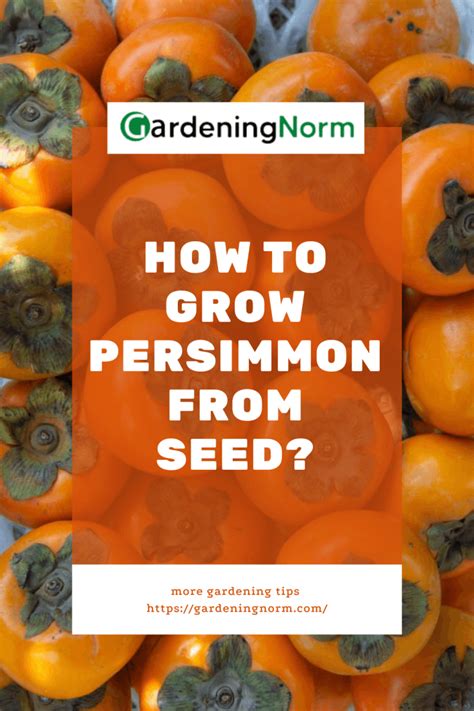Persimmon Seed Starting: A Comprehensive Guide for Beginners
Persimmons, with their vibrant colors and sweet, subtly tangy flavor, are a delightful autumn treat. But growing your own persimmon tree from seed can be a rewarding, albeit challenging, journey. This comprehensive guide will walk you through the entire process, from seed collection to transplanting, equipping you with the knowledge to successfully cultivate your own persimmon orchard (or at least a beautiful tree!).
What Kind of Persimmons Can I Grow From Seed?
This is a crucial first step. There are two main types of persimmons: astringent and non-astringent. Astringent persimmons, like the Fuyu, are only palatable after they've fully ripened and softened to a near-mushy consistency. Non-astringent persimmons, such as the American persimmon (Diospyros virginiana), are sweet and edible even when firm. While you can grow both types from seed, it's important to understand that the offspring from seed may not be identical to the parent tree. Seed-grown trees might exhibit different fruit characteristics, including taste, size, and astringency levels. For guaranteed results, consider grafting or purchasing a named cultivar.
How to Collect and Prepare Persimmon Seeds
Choosing the Right Fruit: Select ripe, healthy persimmons. The seeds should be plump and fully developed.
Extracting the Seeds: Carefully remove the seeds from the fruit. Rinse them thoroughly under cool water to remove any residual fruit pulp. This helps prevent fungal growth.
Seed Scarification: The hard outer shell of the persimmon seed needs to be broken down to allow for germination. You can achieve this through a process called scarification. One effective method is to gently nick the seed coat with a sharp knife or file, being careful not to damage the seed embryo. Another method is to soak the seeds in warm water for 24-48 hours. This softens the seed coat and makes it easier for the sprout to emerge.
Stratification (Cold Treatment): Persimmon seeds require a period of cold stratification to mimic the natural conditions they experience in the wild. Place the prepared seeds in a damp paper towel or a mixture of moist peat moss and perlite in a sealed plastic bag. Refrigerate this mixture for 60-90 days. This chilling period will break dormancy.
Sowing the Persimmon Seeds
Choosing the Right Potting Mix: Use a well-draining seed-starting mix, avoiding heavy clay soils. A blend of peat moss, perlite, and vermiculite works well.
Planting: Sow the seeds about ¼ inch deep in individual small pots. This allows for easier handling during later stages of growth. Keep the soil consistently moist but not waterlogged.
Germination: Germination can take several weeks to months. Be patient and maintain consistent moisture levels.
Caring for Young Persimmon Seedlings
Light: Provide plenty of sunlight, ideally at least six hours a day.
Watering: Water regularly, keeping the soil consistently moist but not soggy. Overwatering can lead to root rot.
Fertilizing: Once the seedlings have developed a few true leaves, you can start fertilizing them with a diluted, balanced liquid fertilizer, following the manufacturer's instructions.
Repotting: As the seedlings grow, repot them into larger containers to provide more space for root development.
Transplanting Your Persimmon Seedling
Once the seedlings have reached a manageable size (about 1-2 feet tall), they can be transplanted outdoors. Choose a location that offers:
- Full sun: At least 6-8 hours of direct sunlight per day.
- Well-drained soil: Persimmons don't tolerate waterlogged soil.
- Protection from strong winds: Especially during their early years.
H2: How long does it take for a persimmon tree to produce fruit from seed?
It typically takes 5-10 years, sometimes even longer, for a persimmon tree grown from seed to start producing fruit. Patience is key! The time to fruiting can also vary depending on the cultivar and growing conditions.
H2: What are the common problems when growing persimmons from seed?
Common problems include:
- Root rot: Caused by overwatering. Ensure good drainage.
- Pest infestations: Monitor for common pests and treat accordingly.
- Disease: Maintain good sanitation practices to prevent fungal diseases.
- Slow growth: Be patient, as persimmon seedlings can be slow growers.
H2: Can I grow a persimmon tree from a store-bought persimmon?
Yes, you can try, but remember that the resulting tree may not be identical to the parent tree. The fruit characteristics might differ.
H2: Is it easier to grow persimmons from cuttings or seeds?
Growing persimmons from cuttings is generally faster and more reliable for producing fruit that's true to the parent tree, while growing from seed is slower and less predictable.
This comprehensive guide provides a foundation for successfully starting persimmons from seed. Remember that patience and consistent care are essential for nurturing these beautiful and fruitful trees. Happy growing!

